Table of contents
- Carlo Pernat in portrait The last of its kind
- “He really pissed me off!”
- “I thought this was the new Schwantz!”
- “So we filled him up and he signed”
- Racing bosses met at the Castiglioni Palace
- “Max wasn’t an easy person”
- 3 million euros annually, 10 engines, 25 chassis
- He became a beast on the racetrack
- Death threat against Simoncelli
- “It’s not easy with Andrea Iannone”
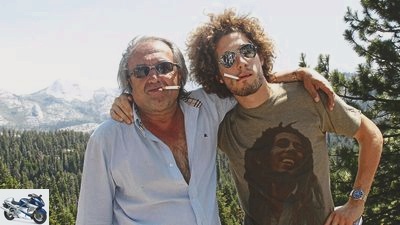
Gigi Soldano
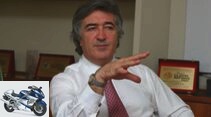
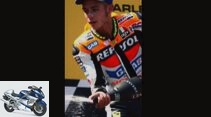
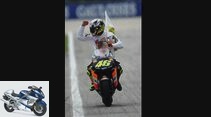
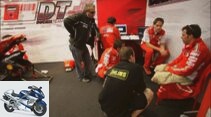
10 pictures
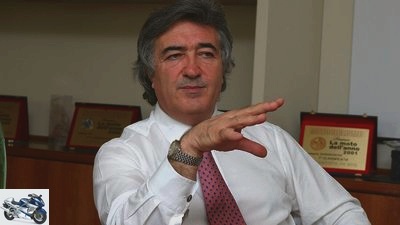
Alan Cathcart
1/10
As head of Cagiva, Claudio Castiglioni was the first to swap office chairs for racing suits in order to drive the new 500cc racing machine
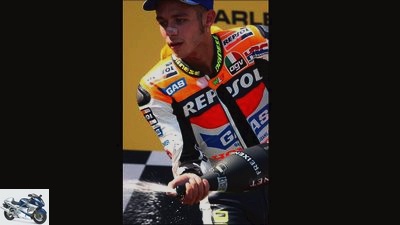
PAUL BARSHON – 2SNAP / SMPMEDIA
2/10
Valentino Rossi on the way to becoming a legend. However, Pernat could not have suspected that he would one day become nine-time world champion
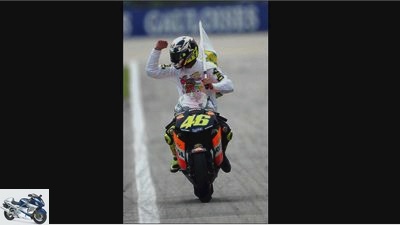
PAUL BARSHON – 2SNAP / SMPMEDIA
3/10
Honda and Rossi. Without this combination, the history of GP racing might have been different. A certain Max Biaggi also plays an important role in this
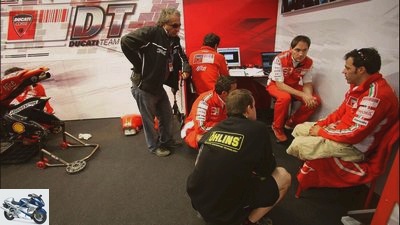
Peter Fox
4/10
Pernat’s recipe for success as a manager is based on a fundamental thesis: “You have to circle the driver 360 degrees and always be there”
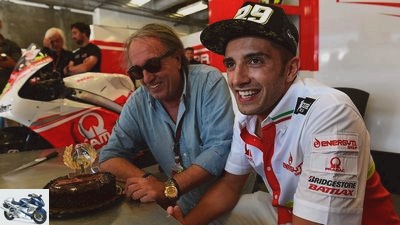
Gigi Soldano
5/10
A phone call from Andrea Iannone brought Pernat back into play six months after Marco Simoncelli’s accidental death
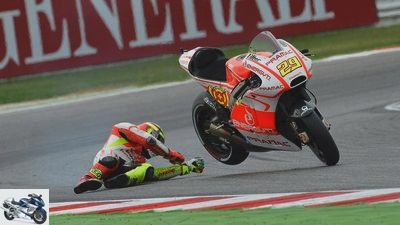
2Snap
6/10
Carlo Pernat has deep trust in his youngest protege Iannone: “He could be the next world champion, but things are a bit like Dr. Jekyll and Mr. Hyde. …
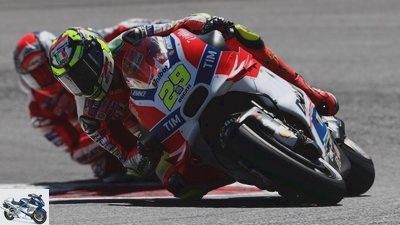
2Snap
7/10
…Andrea is friendly privately, but he gets too dogged when driving ”
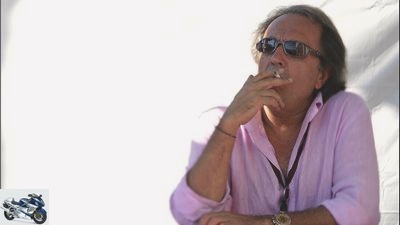
Peter Fox
8/10
“I was very lucky to be able to work for two manufacturers at cagiva and aprilia with bosses who are crazy about racing”
Carlo Pernat
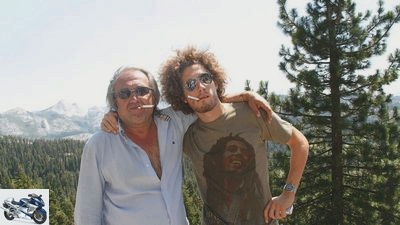
Gigi Soldano
9/10
Portrait of Carlo Pernat
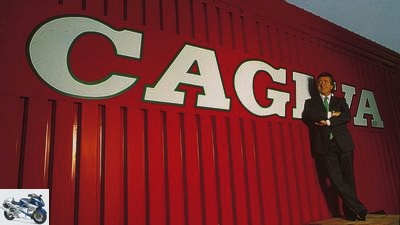
Alan Cathcart
10/10
Sonorous model names such as Mito were sometimes created at Cagiva at nighttime over a beer. Pure passion!
Sports & scene
Carlo Pernat portrait
Carlo Pernat in portrait
The last of its kind
Content of
Jokes, jokes and the MotoGP World Championship don’t go together? If you ask Carlo Pernat, yes. The man helped Valentino Rossi get his first bike, managed Marco Simoncelli and now looks after Andrea Iannone. For PS he opened the sewing box wide.
Mat Oxley, Tobias Munchinger
10/01/2017
For one, maybe even two decades, MotoGP has been disciplined and mostly “clean”. Gary Nixon, US champion from 1979 and notorious Hell-Raiser, said splendidly in 2011 shortly before his death: “Man, the pace of these guys is so fast that they no longer have time to celebrate!” Paddock primarily in a workplace. Everyone takes care of their task in a sober and professional manner.
Buy complete article

Carlo Pernat in portrait
The last of its kind
8 pages) as PDF
€ 2.00
Buy now
Things were completely different in Nixon’s day. Back then, the paddock was mostly made up of wild men who wanted to escape the nine-to-five lifestyle as quickly as possible and looked for adventure on every corner. There is now only one surviving member of this group: the best thing to do is to look out for the clouds of tobacco vapor that swarm around a slowly graying, wild head of hair. Ladies and gentlemen, curtain up for Mister Carlo Pernat!
“He really pissed me off!”
The Italian has been hanging around the paddock of the Road World Championships, the pits and at press conferences since the 1980s. He knows everyone and has worked for almost everyone before. He was active in team management, marketing and PR for Vespa, Gilera, Cagiva and Aprilia. He also worked as the personal manager of Max Biaggi, Loris Capirossi and Marco Simoncelli. Today he looks after Andrea Iannone.
In 1995, as head of the Aprilia racing department, Valentino Rossi got his first job as a racing driver. He supported the then unknown teenager with a certain amount so that he could compete in the 125cc European Championship.
Pernat is an incredibly entertaining storyteller. He will never forget the day he saw Rossi drive for the first time. “Valentino’s father Graziano and I are friends, and Valentino can’t thank his father enough for the help he got from him,” says Pernat after one or three drinks in the paddock restaurant. “Graziano called me every day for two weeks. He really pissed me off! In the end I agreed to go to Misano and have a look at the boy. “
“I thought this was the new Schwantz!”
Pernat turns around and reports how he was still working for Cagiva a few years earlier: “We were told to give a new, unknown driver the opportunity to test our 500cc GP machine. His name was Kevin Schwantz. During the test drives he was just amazing – he drove incredible lines and handled the 500 like a bicycle. He really impressed us, but then he signed with Suzuki. “
When Carlo Pernat saw Valentino Rossi drive for the first time, he was immediately reminded of Kevin Schwantz: “I thought it was the new Schwantz! It was exactly the same scenario, Valentino drove impossible lines and was absolutely playful with the machine. I signed a three-year contract with Graziano and Valentino straight away! Nobody could foresee at this point that he would win nine world championship titles. But he really impressed me back then. “
Pernat left Cagiva in 1990 to work for Aprilia. Back then, the Noale forge was still a little light in the GP circus. When Pernat turned its back on the manufacturer in 1998, Aprilia had seven driver and constructor world championship titles in the bag.
“So we filled him up and he signed”
“I was lucky to be able to work for two manufacturers who were in the hands of racing enthusiasts: Claudio and Gianfranco Castiglioni at Cagiva and Ivano Beggio at Aprilia. When Cagiva had built the new 500, Claudio jumped up and swapped an office chair for a racing suit. Claudio Castiglioni was always the first to test the new machine, ”says Pernat. “At Cagiva we often worked in the office until midnight: Claudio, Gianfranco, I and a few other people sat there. We had our feet on the table and drank beer. Sometimes there were a few girls with them. Meanwhile we come up with names for our new street bikes. The name ‘Mito’ and many others were born on such evenings. “
Back then, there was no getting around the Castiglionis in the Italian motorcycle business. In 1986 Ducati was on the ground. They built a few hundred bikes a year and made diesel engines for trucks. One fine day a helicopter landed on the company roof and three knights, the Castiglionis and Pernat, got out. “If the Ducati brothers hadn’t bought it back then, the shop would have gone downhill,” Pernat estimates.
Before Carlo Pernat moved to Aprilia, he turned Cagiva into a successful racing team. He landed one of his biggest coups in 1987 when he hired Randy Mamola – Cagiva’s first real hope for the title. Pernat remembers the night he convinced Mamola’s manager Jim Doyle to sign the contract: “Jim, Randy, Gianfranco, Claudio and I were sitting at the table together. Eighty percent of the time the contract was okay for both parties, but Jim wanted more money. I knew about Jim’s weakness for grappa. So we filled it up and he signed it. ”Carlo Pernat was never too frightened to use somewhat unfair means if he wanted to achieve something. Racing is more than just driving around in circles. It’s like war, only without the use of weapons.
Racing bosses met at the Castiglioni Palace
Another story takes place in 1985 in Salta, northern Argentina, where the decision in the 125cc Motocross World Championship was the focus. The duel between Honda and Cagiva came to a head. The fuel quality was a real problem, so all the big teams brought their gasoline from Europe. Pernat: “I knew the customs people and I knew what to do. They gave us our fuel. But not Honda. The world association FIM asked me to sell some of our fuel to Honda. I said: Sure, no problem at all. That makes $ 200 a liter. Honda of course waved it off. But I just said, okay, you heard my offer. ”The Honda engines didn’t survive the race and victory went to Cagiva. Incidentally, the following Monday the petrol for Honda arrived.
The Castiglionis knew how to increase their influence in business in a rather clever and often insidious way. They controlled their business in the motorcycle world from Varese. They ran a fancy hotel there, “The Palace”. For several years, the racing bosses of all major companies met at the Palace and discussed the future of the sport. These included big names such as Mitsuo Itoh from Suzuki, Mike Maekawa from Yamaha and Suguru Kanazawa from Honda. “They didn’t pay anything for their stay there, everything was taken care of,” laughs Pernat. “We usually had a meeting a few days after the guests arrived, which usually went pretty well for the Castiglionis. During this time there was a lot of support for Cagiva from Honda and Yamaha. Maekawa helped us with the chassis and Honda allowed us to use Kokusan ignition systems. I flew to Japan and came back with four or five of those things. “
“Max wasn’t an easy person”
While at Aprilia, Pernat was notorious for getting the gentlemen of the press to his side. “After many races, I grabbed all the Italian journalists, drove to the casino with them and paid for the evening.
This phase was full of sex, drugs and rock ´n ‘roll and for me it was a natural part of my motorcycle world. I mean, why do you think people buy motorcycles? To be free! To do whatever you want! ”At the end of 1998, Pernat left Aprilia to devote more time to looking after individual drivers. His first client was called Max Biaggi. However, this relationship did not last long. “Max wasn’t an easy person because he didn’t trust anyone. To this day I don’t know why. Maybe it was because his mother left him when he was very young. “
Pernat has a fascinating theory about what might have happened in Grand Prix racing if Biaggi and Mick Doohan hadn’t gotten each other’s hair: “Max won his first 500cc Grand Prix on the Honda, but then got into an argument with Doohan one. That was pretty stupid because Doohan no longer wanted him on the factory team in 1999 as a result. Imagine what would have happened if Max and Mick had just been friends. Biaggi would have got a place on the Repsol team. Mick injured himself at the time, and with material from the factory Max would certainly have won the title. Then what would have happened to Valentino as he rose to the 500s? He couldn’t have gone to Honda because of Max. So he would have hired Yamaha to first drive the YZR 500 and then the first M1, which really wasn’t a good motorcycle. At the time, Max definitely cut his own flesh with his behavior. “
3 million euros annually, 10 engines, 25 chassis
Carlo Pernat had such big names as Biaggi, Rossi, Capirossi, Simoncelli and Iannone under his thumb. Five fundamentally different types, which he characterizes as follows: “Iannone and Biaggi may have a certain similarity in common, while Simoncelli was more like Rossi. Capirossi was somewhere in between. Flexibility is most important as a manager. You have to get involved with the driver, not the other way around. I treated Valentino very differently than I did with the other drivers. My method is to circle the driver 360 degrees and accompany him permanently. From the first test drive of the season to the very last. You always have to be there to help with all sorts of matters. No matter whether it is a psychological thing, support and help in dealing with the press, the sponsors or the team. Many of the modern managers only show up here and there to sign contracts. I don’t like these guys. “
It will hardly be a coincidence that Pernat’s last proteges Capirossi, Simoncelli and Iannone all share his passionate approach to life and racing. Pernat accompanied Capirossi during his time in the Premier Class with Pons Honda, Ducati and Suzuki. It would have been easy for the 125cc and 250cc world champions to become the star of the Kawasaki MotoGP team, Pernat ponders: “When Kawasaki entered the MotoGP World Championship in 2002, they licked their fingers for Loris. They offered him a three-year contract with an income of three million euros a year and flew us to Tokyo, where the top boss of Heavy Industries received us in the restaurant of his skyscraper. So we ate and talked. He promised us we could get whatever we wanted: ten new engines, 25 new chassis. They really had a huge budget. “
He became a beast on the racetrack
But there was an obstacle. “But then they told us that because of the partnership between the two companies, the team should definitely use Dunlop tires. We preferred Michelin, so our contract was that if we have to use Dunlops, we won’t drive. On the other hand, if we are allowed to use Michelins, we drive. We returned to Italy and Ducati offered us a huge deal for 2003, 2004 and 2005. It was so good that I called Michelin straight away and asked them not to sell tires to Kawasaki under any circumstances, ”says Pernat. You could be shocked now. But that’s how racing works. Pernat is just one of the very few who talk about it openly and bluntly.
A little later the Simoncelli family approached him: “That was in 2007 after the Grand Prix in Turkey. We were sitting in a hotel bar somewhere in Istanbul. Marco’s father Paolo wanted to work with me, so we arranged a meeting at a car grill near Cremona. There we talked to each other and at the end we signed a contract. Actually, I had long since decided that I wanted to work with Marco. If he hadn’t picked me, I would have picked him. Marco was very similar to Loris in some ways – a great guy and a down-to-earth person. Always friendly, no bullshit. But when he was on a racetrack, he became a beast! “
Death threat against Simoncelli
Pernat and the Simoncelli family became good friends: “After Laguna Seca 2011 we went on a big road trip through Colorado. Marco, his family, me and a few friends who drove behind in their own cars. It was a wonderful trip. Marco tried to get me to quit smoking. He rifled through my luggage and broke all of my cigarettes.
I hadn’t smoked for half a day and I wanted to kill him! We were driving down the highway, he passed and looked at me out the window. My butts hung from his ears and nostrils. He was a guy who could make everyone around him laugh. “
Even before Simoncelli’s death, everything was not always sunshine: “After Marco and Dani Pedrosa clashed at Le Mans in 2011, there was a major campaign against him in Spain. A few days before the race in Barcelona there was a letter in Marco’s mailbox containing two bullets and a piece of paper. It read: ‘In Barcelona you will be dead before you even stand at the start line.’ When we arrived at the airport, four Interpol bodyguards were waiting for us, and they didn’t leave our side for the entire weekend. ”
“It’s not easy with Andrea Iannone”
When Marco Simoncelli had a fatal accident in Sepang in October 2011, Carlo Pernat said goodbye to racing for the time being: “Marco’s death is a terrible loss. I don’t know if he would have been able to take a MotoGP title. But he would definitely have done anything and people would have loved him for it. “
Six months after Simoncelli’s accident, Carlo Pernat’s phone rang. The man on the other end of the line was Andrea Iannone. Pernat was back in the game. “It’s not easy with Andrea. I firmly believe that he has what it takes to win. He’s incredibly talented and if he could just be sculpted a little more he could be the next world champion. It’s a bit like Dr. Jekyll and Mr. Hyde. In his private life Andrea is a friendly person, but he’s very dogged when it comes to racing. “
That ended the conversation with the 68-year-old Italian. Carlo Pernat finished his drink, left the table and returned to the paddock, enveloped in a cloud of tobacco smoke. He may be a dinosaur in the GP circus. But at that moment it looked like the dinosaur had set out to terrorize a horde of defenseless sheep.
Related articles
-
2snap Sports & scene Portrait Troy Bayliss Portrait Troy Bayliss Three-time Superbike World Champion Troy Bayliss Content of In 2008, three-time…
-
MotoGP – Dorna boss Carmelo Ezpeleta in portrait
2snap Sports & scene Motorsport MotoGP – Dorna boss Carmelo Ezpeleta in portrait MotoGP – Dorna boss Carmelo Ezpeleta in portrait The show master Excited…
-
Gori counselor technology & future Portrait: Lino Dainese Interview: Lino Dainese “I want to measure the adrenaline” Who invented it? No, for once not…
-
Mick Doohan and Casey Stoner in portrait
2snap Sports & scene Mick Doohan and Casey Stoner in portrait Portrait: Comparison Mick Doohan / Casey Stoner The MotoGP riders from Australia Content of…
-
Portrait of Claudio Castiglioni
archive Sports & scene Portrait of Claudio Castiglioni Claudio Castiglioni The impresario and the Italian motorcycle history Content of For more than…
-
Portrait of a motorcycle enthusiast
Detlev Louis motorcycles Portrait of a motorcycle enthusiast Portrait of a motorcycle enthusiast The person behind Detlev Louis Dozens of shops bear his…
-
Report: Portrait of the Ducati works driver Cal Crutchlow
Wood 11 pictures Gold and Goose Photography 1/11 Someone like Cal Crutchlow spends the whole year flying around the world in business class, puts a…
-
2snap 6th pictures Friedemann Kirn 1/6 Toni Bou has already won 20 world titles in the trial. Friedemann Kirn 2/6 Superstar without special requests -…
-
Scene: Portrait of Ferry Brouwer
Siemer Sports & scene Scene: Portrait of Ferry Brouwer Scene: Portrait of Ferry Brouwer To ask! Content of He was a mechanic for greats like Phil Read…
-
Felix studio to travel Portrait: Harley Club Beijing Conspiratorial meeting with the Beijing outlaws East goes West In a quiet corner, hidden in the…